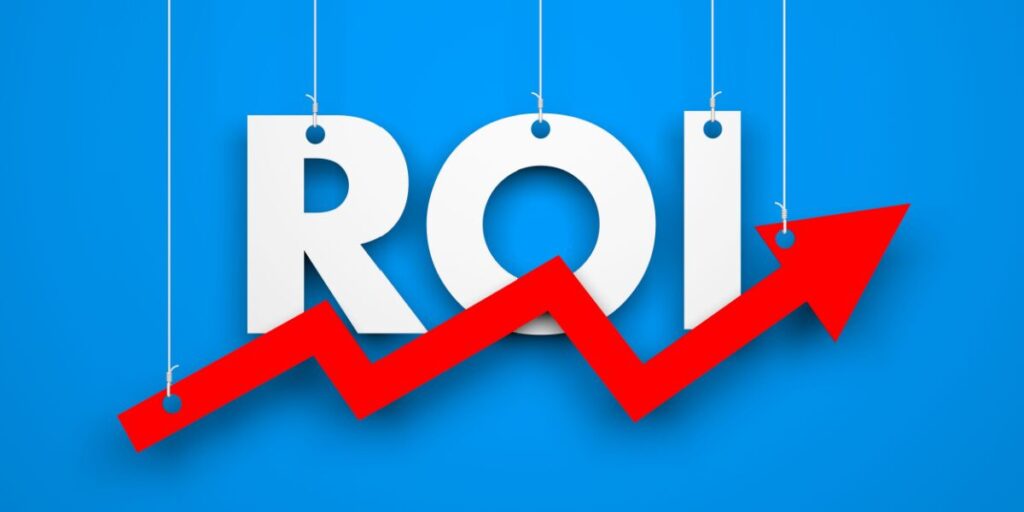Imagine spending money on advertising, printing flyers, running social media ads, or even sponsoring a radio show—and then not knowing if any of that effort helped you get more customers. That’s like pouring water into a bucket with holes.
This is why every business owner, marketer, or entrepreneur must understand marketing ROI, which refers to the profit generated from marketing efforts compared to the expenses incurred.
It’s not just about making noise; it’s about making smart decisions that help your business grow.

Whether you run a small boutique, an online store, or a tech startup, this article will help you understand, in everyday language, how to check if your marketing is bringing in money or wasting it.
What Exactly Is ROI in Marketing?
Let’s break it down simply.
ROI stands for Return on Investment. It’s a fancy way of asking, “Did my marketing bring in more money than I spent?”
Here’s an example you can relate to:
Let’s say you run an ad on Instagram and spend ₦100,000. If people who saw that ad end up buying your products and you make ₦300,000 in total sales, then your campaign worked well.
That means for every ₦1 you spent, you got ₦3 back. That’s a good return.
On the other hand, if you spend ₦100,000 and only make ₦80,000 in sales, you actually lost money. That’s a poor return and a red flag that something needs to change.
Set Clear Goals First
Before you start measuring results, ask yourself, what do I want this campaign to achieve?
You can’t measure success without first knowing what you’re chasing. Your goal could be:
- To get more people to buy from you
- To have more people call or message you
- To grow your email list or get signups
- To get more visits to your website
- To make more people aware of your brand

freepik
Setting a goal gives you direction. It also helps you choose the right things to track. If your goal is sales, you’ll measure how many people bought. If your goal is signups, you’ll track how many people submitted their details.
The Key Things to Track When Measuring ROI
Once you know your goal, the next step is to track the right numbers that help you understand if your campaign worked. Below are the major ones you should care about:
1. How Much You Made From the Campaign
This is the total amount of money that came in as a result of the campaign. For example, if you’re running an ad and it leads people to your online store where they buy something, that total income is what you measure.
2. How Much Did You Spend on the Campaign
This includes everything—the cost of the ad, the cost of creating a video or poster, the money you paid an influencer, or any software you used.
3. How Many New Leads or Enquiries did you get
If people didn’t buy immediately, but they reached out, called, or submitted their details, they are called “leads.” You can track how many of these you got.
4. How Many People Actually Made a Buying Decision
It’s not just about clicks and visits. How many people pulled out their wallets or completed a purchase? That’s what counts.
5. How Much Each New Customer Is Worth Over Time
This one is a little deeper, but here’s the idea: some customers will buy from you once and never come back. Others will buy again and again. If a customer spends ₦10,000 now and another ₦30,000 over the next few months, that’s ₦40,000 from one person.
Knowing this helps you decide how much you’re willing to spend to get that one customer.
Examples of Campaigns and How to Measure Their Results
Let’s go through a few popular types of marketing and see how ROI can be measured in each one.
1. Social Media Ads
Let’s say you run ads on Facebook or Instagram. These platforms show you how many people saw your ad, clicked on it, and even bought something if you connected your website or store properly.
You can measure:
- How much did you spend
- How many people clicked
- How many of those people bought
- How much money came in as a result
If you spent ₦50,000 and made ₦200,000 in sales, you’re doing well.
2. Email Marketing
If you send out a message to your list of subscribers offering them a discount, you can track:
- How many people opened the email
- How many clicked on the offer
- How many made a purchase
You can even create a special discount code in the email so that you can easily track who bought because of that message.
3. Working with Influencers
Let’s say you pay an Instagram influencer to talk about your product. You can give them a unique discount code (e.g., “Kemi15”) so that every time someone uses it, you’ll know the sale came from her.
That way, you can count how many people bought through her and see if she was worth the investment.
4. Billboards, Flyers, or Radio Ads
These are harder to track, but not impossible. You can include a special phone number, website link, or even a secret code that people must mention. That way, when people call or visit, you’ll know it came from that specific campaign.
Tools That Can Help You Measure ROI
If you want to make your life easier, you can use tools that help you track performance without doing all the math yourself. Here are a few:
1. Google Analytics
This is a free tool that shows you how many people visited your website, where they came from (Facebook, Google, etc.), and what they did on your site.
2. Social Media Insights
Facebook and Instagram show you data on how many people saw your ad, liked it, commented on it, clicked on it, and bought it (if connected to a store).
3. Email Platforms (like Mailchimp or Sendinblue)
These tools show you how many people opened your emails, clicked on links, and responded to your offers.
4. UTM Links
This is a special way of creating links that tells you exactly which campaign or platform a visitor came from. Very useful for tracking.
5. CRM Tools
If you run a business with a sales team or you follow up leads manually, customer relationship management tools help you track every stage from lead to sale.
Common Problems People Face When Measuring ROI
Even with the best intentions, measuring ROI can be tricky. Here are some issues many business owners face:
1. Not Knowing Where Customers Came From
If you don’t track, you won’t know if a sale came from your Instagram ad or a blog post. That’s why using unique links, codes, or proper software is so important.
2. Delayed Results
Sometimes, people won’t buy immediately. They might see your ad today, but buy next week. That makes it harder to know if the campaign worked—unless you’re using tools to track their journey.
3. Focusing Only on Immediate Sales
Not all campaigns are meant to bring money right away. Some are for building brand awareness, which leads to sales in the future. If you’re only looking for quick returns, you might miss the bigger picture.
Also Read: 10 Proven Marketing Strategies for Small Businesses That Actually Work
How to Get Better ROI From Your Campaigns
If you want your campaigns to perform better and make you more money, here are some helpful tips:
1. Know Your Audience
Don’t waste time showing your ads to the wrong people. Focus on your ideal customers—those who are most likely to buy.
2. Keep Testing and Improving
Run different versions of your ad. Test different headlines, images, and offers. Over time, you’ll see what works best.
3. Retarget Interested People
If someone visited your website but didn’t buy, you can show them ads again to remind them. These are called retargeting ads, and they often lead to high sales.
4. Focus on Good Content
Whether it’s an email, blog post, or video ad, make sure the content is engaging, clear, and convincing. The better your message, the better your results.
5. Follow Up With Leads
If someone showed interest but didn’t buy, reach out. A simple phone call or reminder email can turn a lead into a customer.
A Real-Life Example You Can Relate To
Let’s say a woman runs a small skincare business. She decides to pay an influencer ₦100,000 to promote her brand. In the next two weeks, she notices an increase in orders and realizes she made ₦400,000 in sales from customers who used the influencer’s discount code.
She spent ₦100,000 but got ₦400,000 in return. That’s a very good result—and that tells her the influencer was worth it.
Now, if she had run the campaign and didn’t track results, she would never know if it worked or not. That’s why tracking ROI is important—it shows you what’s bringing in money and what’s wasting it.
Also Read: 10 Essential Elements of a Strong Business Model That Drives Growth and Profit
Marketing ROI Is About Smart Spending
Marketing is powerful, but only if it’s done wisely. Measuring ROI helps you avoid guessing and start making data-based decisions. It helps you know where to put your money next time and where to pull back.
Remember, you don’t need to be a math guru or marketing expert to track ROI. All you need is:
- A clear goal
- A way to track what happens
- A simple review of what you spent and what you got back
That’s it. Start small, stay consistent, and keep learning from every campaign you run. When you do that, marketing stops being a gamble and becomes a money-making machine.


